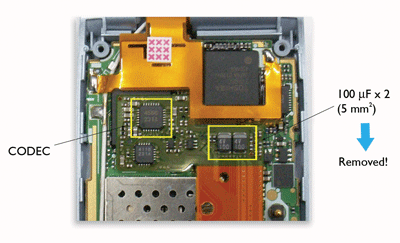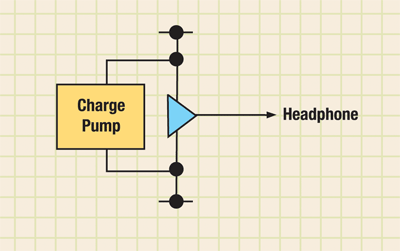Design considerations for driving headphones
Headphone-drive designs are now available to provide high-quality audio output while saving circuit-board space
BY WILLIAM R. GLINKA
The mobile phone got the ball rolling and Apple’s iPod gave it unstoppable momentum: portable electronic devices are in huge demand. As developers squeeze more features into portable electronic devices and they get easier to use, demand is only growing as new segments of the consumer market discover that they can’t live without them anymore.
But for all the diversity in function and fashion, one thing is standard across the board. Because they are portable, and therefore used in public, portable electronics that make sound need headphones.
Traditional approach
In traditional headphone-driver design, the audio signal is translated to a digital signal by the codec and turned into analog voltage signals by the DAC, and then passed to an amplifier, which drives the headphone jack or line-out jack (which are often the same jack). But since a simple amplifier cannot produce positive and negative voltage, the signal must be dc biased and swing around VCC /2 instead of zero.
In order to block this dc bias from reaching the headphones, and to allow the headphones to use a true ground, a filtering capacitor is used. This is an effective, and well-understood method that has been used for years, but its disadvantages have caught up with the restrictions imposed by the continued evolution of portable electronics design.
The filtering capacitor is a large, bulky, passive circuit element taking up far more than its fair share of circuit-board real estate (see Fig. 1 ), and its size is proving to be an uncomfortable roadblock as portable electronics continue to shrink. Using smaller capacitors requires using less capacitance, which reduces the low-frequency response of the circuit. This is hardly an option when the highest-quality audio output has been painstakingly produced by a good codec chip and a high-resolution DAC. Furthermore, this approach creates an unpleasant “pop” when the system is first turned on as the dc bias hits the headphone speakers, and the filtering behavior caused by the capacitor will change depending on whether 16- or 32-Ω speakers are used.

Fig. 1. The filtering capacitor takes up far more than its fair share of circuit-board real estate, proving to be an uncomfortable roadblock as portable electronics continue to shrink.
Three alternative approaches are now available to provide high-quality audio output for headphone drivers while saving circuit-board space. The trick is to eliminate the need for the bulky filtering capacitor, and choosing the best approach for a specific application is critical.
The first is a “pseudo-capless” design, which simply eliminates the filtering capacitor. While this saves board space, it eliminates the true ground reference from the headphone jack, limiting its functionality.
The second approach is “differential drive” design, which independently drives the left and right headphone speakers with a push-pull circuit, but sacrifices the ground reference altogether and uses a nonstandard four-conductor jack.
The third approach is a true “capless” design that uses a charge pump to provide the real positive and negative voltage all the other approaches lack.
Pseudo-capless
The pseudo-capless design is very similar to the traditional design except that it eliminates the filtering capacitor (see Fig. 2) . Although this design still drives headphones well at a low cost, it sacrifices the true ground connection in favor of a dc-biased false ground (VCC /2).

Fig. 2. The pseudo-capless design is very similar to the traditional design except that it eliminates the filtering capacitor.
In a closed system this is not a significant problem, although the headphone jack can no longer be used as a line-out to interface with other audio equipment. The lack of a true ground reference means that the headphone will try to apply its dc bias to whatever it is plugged into, which may damage the headphone driver or the circuit it is being made to drive.
If the system is closed, or if the design can ensure that the jack will be used only for headphones and not a line out, the pseudo-capless solution provides an effective low-cost solution that is very similar to the traditional design. However, it does suffer from some of the limitations of the traditional design as well. Since the signal is still dc biased, the headphones will still suffer from an audible pop when the system is turned on.
Because these two designs drive a signal around VCC /2 rather than a true ground, the maximum voltage they can output is cut in half. This means that in order to get a good response from the headphones, higher voltages are required, usually 3 or 5 V. The other two designs have the advantage of producing negative voltages, which means not only do they get the full +VCC voltage level but also VCC to drive the headphones. This means they can output four times as much power as the traditional and pseudo-capless designs given the same voltage. In practice, they are used to provide the same power output with much lower voltages, typically around 1.8 V.
Differential drive
The differential drive design is a departure from the traditional design in that the jack requires four conductors, an independent positive and negative for both right and left. This design uses a push-pull driver to use all the available voltage from +VCC to -VCC . A low-voltage 1.8-V supply can produce plenty of power with this design. Additionally, the lack of a common dc-bias voltage means the speakers will not pop when turned on.
However, the push-pull design means that the differential drive does not have a true ground either, and therefore using the headphone jack as a line out is not recommended. The nonstandard jack could also be seen as a disadvantage, but on the other hand also does more to discourage the end user from attempting to use it as a line out.
Keep in mind, however, that a poorly protected amplifier could short-circuit and burn out if this is attempted anyway as the three-conductor jack shorts some of the four-conductor rails together. The fourth conductor is also therefore not available for a hands-free headset.
True capless
The true capless design is a fully solid-state solution that eliminates the disadvantages of the other designs while maintaining the most attractive qualities of all of them. An integrated charge pump (see Fig. 3) or more rarely a dual-rail power supply, provides both positive and negative voltage around a true circuit ground, meaning the headphone jack can be used as a line out to drive other audio equipment without risking damage to either device.

Fig. 3. The true capless design eliminates the disadvantages of the other designs while maintaining the most attractive qualities of all of them.
Like the differential drive, the capless design uses all of the available voltage so it can provide good power output at the lower 1.8 V, and the lack of a dc bias means it will not pop the speakers when turned on. Like the traditional and pseudo-capless designs, it uses a standard three-conductor jack. All of this functionality comes at a price, however, so it is important to weigh the cost against the need.
Whether the device is a cell phone or an mp3 player, portable audio demands high-quality headphone drivers to match the codec and DAC. All three of the cap-free options have their advantages and disadvantages, so care must be taken to match the features with the application.
A basic mobile phone might not need line-out capability if it is only going to use a hands-free headset, but if it has a built-in MP3 player then it might. If smaller size is the only key requirement, the pseudo-capless design may be all that is needed. If higher power and pop-free operation is important, the differential drive could be the best fit. But if a true-ground high- power output, a line-out option, and pop-free operation are all necessities, the true capless design will provide all the options the end user could want. ■
Visit http://drivingheadphones.electronicproducts.com to see full coverage of driving headphones
Sponsored by AKM Semiconductor • www.akm.com
AKM Semiconductor (AKMS) is a wholly owned subsidiary of Asahi Kasei Microsystems Co, (AKM), Tokyo, Japan. Located in San Jose, CA, AKMS offers sales, marketing, and design support for North American customers. AKMS designs and manufactures CMOS mixed-signal ICs for applications including audio, multimedia, data storage, and telecommunications.
Advertisement
Learn more about AKM Semiconductor





